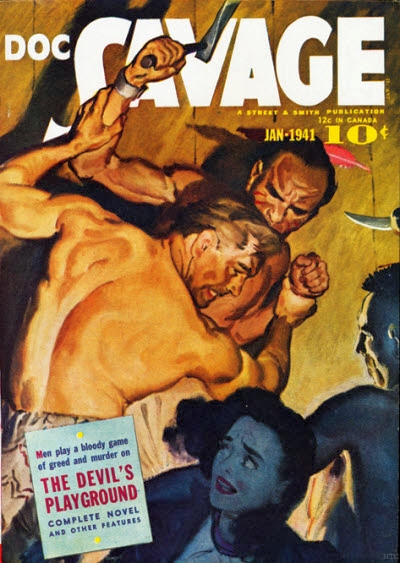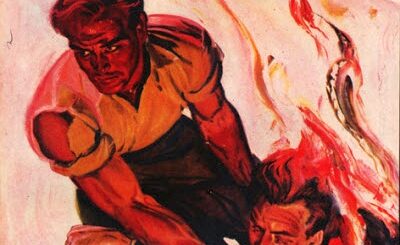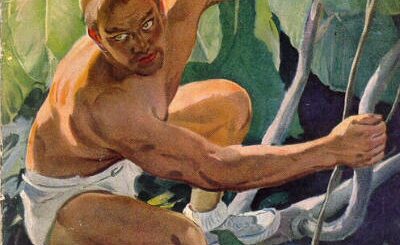The Devil’s Playground
Night after night the Indian drums boomed their terrifying portent of evil and destruction. And each night another victim of “the thousand cuts” lay dead in the forest. Doc Savage grapples with the eerie and sinister Michabou, the great spirit of the primitive Ojibway tribe, in the Herculean attempt to cease the senseless blood bath of the Devil’s Tomahawks, and to quiet forever the mysterious drums of murder.






Run of the mill Doc tale, though still enjoyable. Remarkable as yet another example of Dent’s vast knowledge of geographical region-specific information.
I agree with what was said above, especially about Dent. While this tale is average (for a Doc adventure) we find yet again a dazzling display of Dent’s unique ability to capture locations and peoples. His grasp of cultural nuances and regional geography is almost uncanny. He always seems to know everything about the soil, trees, lakes, rivers, and animals of any given area, and then weave amongst the hell-bent-for-leather razor’s edge of action some very in-depth snapshots of indigenous peoples’ histories and ways of life, including language, clothing, music, art, and, of course, warfare. He is always several steps ahead of the readers and creates very real, living, breathing expansive worlds for his adventure stories. In this way, he’s a cross between the epic high action, full-blooded passion of Homer and the deep, reflective, naturalist wisdom of a Thoreau.
One might say Dent’s amazing skill as a storyteller and finely tuned balance of coldly calculating scientific knowledge with fluid native intuition borders on being Doc Savage-ish.
Thomas Fortenberry
I don’t think this is a Dent story (Hathaway might have ghosted it). But, it’s still a pretty good story that is very rich in detail and descriptive writing (this is why it doesn’t strike me as a Dent story). I found the torture scene with Monk very well written and Monk never seemed to come across so powerfully as in this book. One complaint was the canoe suddenly becoming a two-man submarine. Still, it’s a good read if a bit implausible and not quite the Doc Savage we’re familiar with. As for the Bama cover, I was wondering if it looks better in its original form. Bama is/was a masterful painter of both cowboys and Indians. I think this painting has all sorts of details Bantam either leaves out or blurs. (This happened to the cover to The Fantastic Island, supposedly one of Bama’s personal favorites.)
This was a novel that I thoroughly enjoyed. I thought the central gimmick, The Tomahawk Death, one of the best “spooky” devices ever, in a Doc Savage story ( one little question, though – given the explanation for this particular device, and I won’t give it away here, how the hell was it able to be employed on a New York street, even at night-time?). Hathway may have written it, but it is up there with the best of Dent, in my opinion. Check it out.
Guess I’m in the minority on this one.. it was so poor I could not finish it. Doc’s devices seemed too far fetched (The submarine canoe, etc.); details like Chemistry description were inconsistent from usual as in this book Monk was able to get him dressed up like himself and trick Ham into pushing him in the lake; far more characters were introduced than were necessary with no real purpose than to act as red-herrings; the fact that Doc is at the Fortress of Solitude but requests his aides call if there is a problem rather than remain isolated as usual; the actions of many of the natives were like they were from a bad western; slow motion gas (!?), and so on. If this one was by Dent, he sure had an off day.
I happened across this book in a used book store–it was my first Doc Savage book (though I loved the 1975 movie as a kid).
According to Wikipedia, this was the first Doc Savage book written by Alan Hathway. There is a lot of good pulp adventure to be had here, but the plotting is a bit confusing, with rapid jumps between “our heroes are going to do something” and “our heroes just died” and “our heroes just did something amazing to survive.” Situations (and people’s attitudes) change suddenly, with very little lead-in or reason for the change. I agree that the “slow gas” was an odd gadget, but everything here is over the top, so why not? Obviously, the native American take here is really dated, but you have to take anything from this era with a grain of salt on that front. Overall, it was a fun read, with just a few plot points where you had to just push through the challenges (again, not unusual for pulp fiction of this era). I’m looking forward to reading some of the Lester Dent adventures.